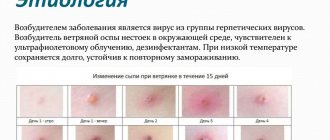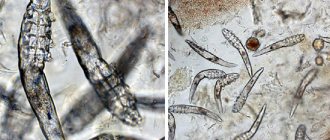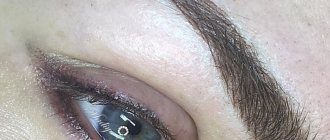From this article you will learn:
- keloid scar and hypertrophic scar - what is the difference,
- laser resurfacing of scars: before and after photos, video,
- what is the best ointment for scars?
A keloid scar is the result of excessive growth of scar tissue. It looks like a hard, smooth, tough, nodular growth, often in various shades of red. Many people mistakenly refer to it as “colloidal scar,” which is a grammatically incorrect name.
Keloid scars (keloids) can begin to form immediately after injury or several months later. They can be significantly larger than the original wound itself. Unlike other types of scars, this type of scars/scars never lighten or become invisible over time.
Keloid scar: photo
They occur on any part of the body where there has been damage to the skin, but the following parts of the body are most susceptible to the formation of keloids: chest, shoulders, neck, knees, ankles, earlobes.
Keloid scar and hypertrophic scar - what is the difference?
Usually, after an injury, the body starts the healing process, as a result of which a regular flat scar forms on the surface of the skin (at the site of the former wound). For reasons still unknown to science, the scar may suddenly begin to thicken, i.e. hypertrophy of scar tissue occurs. Hypertrophy can be of two types, and depending on its type, either a hypertrophic scar or a keloid scar occurs.
- Hypertrophic scar (Fig. 7-9) - is formed if hypertrophy is limited to the area and size of the wound itself.
Most often, hypertrophic scars begin to develop within the first two months after injury, and quickly turn red. The growth occurs for up to 6 months, after which spontaneous regression usually occurs (it stops growing or even decreases slightly). This whole process usually takes 1 year, no more. Timely treatment (cortisone injections or steroids) can speed up the regression process. - Keloid scar (Fig. 1-6) - if the hypertrophy of scar tissue extends beyond the area of skin damage, capturing healthy undamaged tissue - such a scar is called keloid.
This type of scar develops over several years after injury, but can sometimes occur completely spontaneously even without previous injury, such as on the chest. A keloid scar can grow for many years and never regresses like a hypertrophic scar. Moreover, keloid scars often grow again if they were previously removed surgically. This never happens with hypertrophic scars (24stoma.ru).
Other symptoms of keloid scars are:
Keloid scars can be either flesh-colored or red, pink, or darker colors. They can be smooth, nodular or spherical, or simply protrude above the skin in lumps. If the keloid is exposed to sunlight during the first year of formation, the scar may permanently become darker than the surrounding skin. Sometimes a keloid scar will cause itching, irritation, or pain (and these symptoms may be worsened by rubbing clothing).
Nikolay Rubtsov. Biography pages
Unfortunately, he has not been with us for 45 years. Literary evenings dedicated to the poet’s work will be held in many Russian cities. Surgut will not stand aside either, because for more than 20 years, traditionally, Nikolai Rubtsov’s poetry festivals have been held annually in our city. For many years I have been studying the life and work of the poet, collecting his books, autographs, letters, and various documents. I would like to present to readers some pages from his biography.
Nikolay Rubtsov and the Tyumen region
In 2001, literary evenings dedicated to the 65th anniversary of the birth of Nikolai Rubtsov were held in Surgut. Among the guests invited to these celebrations was the poet from Tyumen Nikolai Denisov . He knew Rubtsov, since he studied with him at the Literary Institute. We talked with him for a long time about Rubtsov. He talked interestingly about their meetings and showed rare photographs. I remember, then in a conversation, Denisov recalled that in 1969 he advised the then secretary of the writers’ organization, writer K. Lagunov, to send an invitation to Rubtsov to come to Tyumen for the Days of Literature. But no one saw this letter, and no one knew whether Lagunov sent it or not. In any case, Nikolai Rubtsov did not come to Tyumen. Several years passed, and this topic suddenly “surfaced” again.
In 2004, while in Vologda, I visited the poetess, a close friend of Nikolai Rubtsov, Ninel Aleksandrovna Starichkova (now, unfortunately, deceased). She showed me her archival materials, autographs and things of the poet. At the end, just before I left, Ninel Alexandrovna suddenly went into a small room and brought some piece of paper. She gave it to me with the words: “I don’t know what prevented him from coming. But then at least let you have the letter!” This was the original invitation from N. Rubtsov to Tyumen for Poetry Week. It was this letter that was sent to Vologda at the suggestion of Nikolai Denisov, and this is exactly what he told me about in 2001 at the Rubtsovsky evenings in Surgut. On the letterhead of the Tyumen Regional Writers' Organization, yellowed with time, the following was printed:
"20/X. 1969.
Dear Nikolai!
In mid-December the fourth Tyumen Poetry Week will be held, in which poets from Moscow, Leningrad, Sverdlovsk, Novosibirsk, Omsk, Kurgan and Tyumen will take part.
The Tyumen writers' organization asks you to take part in the Week. During the Week, poets will visit Tobolsk, Yamal, and the Ob region. They will meet with geologists, fishermen, oil workers, grain growers, and builders. They will see with their own eyes how the largest energy giant in the world is being created in the remote, swampy taiga and impenetrable tundra.
Our organization will cover all travel expenses, as well as for participation in collective performances (up to 20 are planned). The Tyumen Propaganda Bureau pays a fee of 30 rubles to each poet. For “solo” poetry evenings, a fee will be paid depending on the collection, but not less than 200 rubles.
During the Week, its participants will speak on Tyumen, Khanty-Mansiysk, Nizhnevartovsk television and regional radio. Their works will be published on the pages of regional newspapers.
We will be glad to see you on the land of Tyumen, among the participants of the poetry week. Please let us know if you agree with our proposal.
With friendly greetings. Executive Secretary of the Writers' Organization K. Lagunov"
I remember that when I received this document, I was glad that Rubtsov’s poems were known and loved in our region even in those years. Later, this topic was replenished with other interesting facts - for example, a response letter from Rubtsov was found. Tyumen poet and prose writer Nikolai Denisov writes about this in his book of memoirs “In an Open Field,” published in Shadrinsk in 2012, an excerpt from which I present to the reader:
“...In the fall of 1969, while “sketching” in our Union lists of writers and poets whom we wanted to invite to the first All-Union Days of Soviet Literature in the Tyumen Region planned in the summer of 1970, I asked executive secretary Konstantin Lagunov to include Nikolai in the list Rubtsova. Lagunov sent an invitation to the poet to Vologda. (This document was given to me by N.A. Starichkova - S.L.) Nikolai Rubtsov responded quickly. Here's what he wrote:
Dear Konstantin Lagunov!
I received your letter with an invitation to Tyumen Poetry Week! I am grateful to you for this proposal and I fully agree to it. In this case, please keep me informed of the matter, please tell me specific steps in this direction.
Warm greetings to Tyumen writers and poets! Nikolay Rubtsov.
My address: Vologda. Writers' organization, 12/XI-69."
“...Our neat secretary-accountant Zinaida Alekseevna Belova, like all incoming letters and documents, put them in place, and “filed” the letter from Vologda. For what reasons Rubtsov’s arrival in Tyumen did not happen in July 1970, I don’t know.”
Nikolai Rubtsov never visited Western Siberia. His response letter was published once in the newspaper “Tyumenskaya Pravda” dated May 15, 2004¸ and then got lost somewhere. All my attempts to find him led nowhere. They say that the letter is kept in someone's personal archive. I can't find it yet. I would like to.
Search for the poet's older brother
On June 26, 1998, a monument to Nikolai Rubtsov was unveiled in Vologda. At the invitation of the Vologda writers’ organization, I was also lucky enough to participate in that event. The day, I remember, was cool and rainy, but a lot of people gathered for the opening ceremony: fellow Vologda residents, admirers of the poet’s talent from other cities, famous writers and artists. The poet’s daughter Elena Nikolaevna arrived from St. Petersburg with her family. As often happens in such cases, it was both solemn and, at the same time, a little sad. At the same time, I met the head of the Rubtsovsky Center in Vologda, critic and literary critic Vyacheslav Belkov.
It was my first time in this ancient city, and Slava showed me Vologda and took me to places associated with Nikolai Rubtsov. We talked for a long time with Vyacheslav about the poet’s work, about his difficult life paths, as well as about the tragic fate of the entire Rubtsov family. (After the death of their mother and the departure of their father to the front, four children were distributed to different orphanages). Belkov told me then that there was still no information about the whereabouts of Nikolai Rubtsov’s brothers, and reminded me that the poet’s elder brother Albert, according to some sources, visited us in the Tyumen region. He asked me to help in the search and gave me his book “The Life of Rubtsov”, on the last page of which the following afterword was written:
“I have been looking for the brothers of the wonderful Russian poet Nikolai Rubtsov (1936−1971) for a long time. The poems and songs of the untimely deceased poet are known to everyone today - “My Quiet Homeland”, “It’s Light in My Upper Room”, “Bouquet”, “The leaves have flown away from the poplars...”. But little is known about Rubtsov’s life. Maybe one of the readers will help me find the poet’s brothers. Here is some information about them:
Rubtsov Albert Mikhailovich. Born in 1932 in Vologda. He lived and worked in the Leningrad region (Vsevolozhsk, Priyutino), then in Vorkuta (worked in a mine?), Donetsk, Sverdlovsk, Crimea... We don’t even know the main thing - whether Albert Mikhailovich is alive now.
Rubtsov Boris Mikhailovich , younger brother. Born on May 23, 1937 in the village of Yemetsk, Arkhangelsk region. He lived in an orphanage and graduated from evening school in Vologda. At one time he lived and worked in the Krasnodar region (the village of Uspenskoye), his wife Valentina was originally from these places. This is where all the information ends... And there is only one request - help me find it!
Unfortunately, in 2006, Vyacheslav Belkov passed away.
I never forgot his request. At poetry evenings, as well as in newspaper articles, he always talked about Nikolai Rubtsov’s brothers. So almost three years passed after my trip to Vologda, the past moved further and further away, and it seemed that we would learn nothing about the fates of Boris and Albert, and we would not find any of them. But, as they say, man proposes, but the Lord disposes. The anniversary year for the poet, 2001, has arrived. Poetry evenings in honor of Nikolai Rubtsov’s 65th birthday were then held at several cultural venues in our city.
Once, after one of these events, journalist Galina Vladimirovna Kondryakova (her professional memory did not fail the experienced journalist!) and said that her friend told her about some Albert Rubtsov, living in the village of Gornoslinkino, Uvat district, Tyumen region . That he allegedly played many musical instruments, wrote poetry, performed in clubs and at weddings. I, of course, became interested in this message, since not only the first and last name corresponded to the poet’s older brother, but also his abilities, and the fact that he was a “tumbleweed” in life.
I urgently, through the chairman of the city’s journalistic organization, Anatoly Prokhorovich Zubarev, sent a request to the administration and police of the Uvat district. Soon the official answer came: Yes! It was him - Rubtsov Albert Mikhailovich, the poet’s older brother! But, unfortunately, he was no longer alive; he died in 1984 and was buried there, in the village of Gornoslinkino. Knowing that the Leningrad writer N. Konyaev was already releasing a book about Nikolai Rubtsov in the ZhZL series, I immediately sent him a copy of the received document. And N. Konyaev managed to publish it. Then he sent this message to Lena, Nikolai Rubtsov’s daughter, and she already passed it on to Albert’s wife, Valentina Alekseevna, as well as his children, Marina and Nikolai, who live in the city of Kommunar near St. Petersburg. As Lena told me, Valentina Alekseevna, after reading the official paper, began to cry, then calmed down and said: “That’s it, thank God! Now your soul will be calmer. “I now know that he was buried humanly and I know where his grave is.”
Now Valentina Alekseevna herself is no longer alive. I still maintain friendly relations with Nikolai Rubtsov’s daughter, Lena, and with the daughter of the poet’s elder brother, Marina.
And the poet’s younger brother, Boris, has not been found to this day. Please respond if anyone knows anything about him.
Old story
Some time ago, another fact from the biography of Nikolai Rubtsov became clear - the poet’s expulsion from the Literary Institute for “inappropriate behavior in the Central House of Writers and the hostel.”
A lot has been written about this story in the memoirs of contemporaries; various names are named that were allegedly involved in resolving the conflict. But not a word is said anywhere about who put the finishing touches on that case. And Nikolai Rubtsov himself did not know about this. I’ll fill this gap - here’s what the famous political figure of the USSR and Russia, poet Anatoly Ivanovich Lukyanov :
“Somewhere at the end of 1964, at that time I was the deputy head of a department of the Presidium of the Supreme Soviet of the USSR, the poet Alexander Yashin called me and asked to receive him on a very important matter. At the appointed time, Yashin came not alone, but with the poetess Veronica Tushnova. The essence of their request was this: the Vologda poet Nikolai Rubtsov was expelled from the Literary Institute, and he and Tushnova asked me to help with his restoration. By this time, I already knew this name and read collections of his poems in the magazines “Young Guard”, “Youth”, “October” and understood that Nikolai Rubtsov was a great talent, that this was a real phenomenon in Russian poetry.
I called the Literary Institute, introduced myself, and talked about the poet with the rector (I don’t remember his last name now). He said something like this: “Don’t you understand? You are making an unforgivable mistake. You are expelling, perhaps, the second Yesenin from the institute. This absolutely cannot be allowed!” (By the way, V. Kozhinov said almost the same thing to his father when he invited Rubtsov to his house on New Year’s Eve 1965).
They listened to me politely and promised to settle this matter. After some time, they called back and notified that the poet had been reinstated, only for the correspondence course. And in order to show me, as I understand it, what concessions the leaders of the Literary Institute made, they even sent a copy of Nikolai Rubtsov’s lines that were “circulated” around the institute; they are now known to everyone. I treasure this piece of paper to this day.
“Perhaps I am flickering for you in a coffin,
But I tell you in the end:
I, Nikolai Mikhailovich Rubtsov,
I deny the possibility of a sober life.”
Nikolai Rubtsov was reinstated, and then successfully graduated from the Literary Institute.”
Recorded from the words of A.I. Lukyanov, and then read it to him.
On behalf of all admirers of Nikolai Rubtsov’s talent, I thank Anatoly Ivanovich Lukyanov, poet and politician, and just a good person for his participation in the fate of the Russian poet.
Surgut, Tyumen region
Keloid scars: causes of occurrence
During the wound healing process, fibroblasts begin to actively synthesize collagen. Sometimes, for some reason, fibroblasts begin to produce more collagen than is necessary for the normal wound healing process. In this case, the scar begins to grow, forming a keloid. According to studies, collagen synthesis in keloid scars is 20 times higher than in normal scars.
Keloids can develop from a variety of skin injuries, including - → surgical incisions, → wounds on the skin after injury, → vaccination injections, → acne (pimples and pimples), chicken pox, → piercings of various parts of the body (including piercings of the earlobes).
Surgical removal of scars and scars –
It is much easier to prevent the appearance of keloid scars by using special ointments or silicone patches than to treat scars that have already appeared.
Surgical treatment consists of excision of the keloid scar using a scalpel or surgical laser. Surgical removal of scars with a laser should not be confused with the procedure of laser resurfacing of scars. The latter is a conservative non-surgical procedure. However, for keloid scars, surgical treatment methods are quite risky, because the operation may cause the formation of a similar or even larger keloid in the place of the previous one. Therefore, if excision is nevertheless used, then immediately after the operation all possible preventive measures are used to avoid relapse -
→ special ointments for scars, → corticosteroid drugs, → long-term wearing of a pressure bandage or compression garments after surgery.
Excision of a keloid using a surgical laser: video
Non-surgical methods for treating keloids -
In addition to surgical treatment, there are other treatment options that can significantly reduce the size of the keloid and also make it lighter.
Laser resurfacing of scars –
This is one of the common methods of dealing with scars, not only keloids, but also hypertrophic ones. Typically, fractional lasers, argon laser, neodymium laser (YAG), CO2 lasers (carbon dioxide), pulsed dye lasers are used for this. Laser scar resurfacing helps make scars appear flatter and less red. The treatment is safe and not too painful, but several sessions are usually required.
The first video shows laser resurfacing of scars: before and after photos. The second video shows laser resurfacing of keloid scars, combined with steroid injections.
Corticosteroid injections –
Corticosteroids reduce excessive scarring through the following effects: → they reduce fibroblast proliferation and activity, → they reduce collagen synthesis, → they reduce the synthesis of glycosaminoglycans, → they reduce the synthesis of inflammatory mediators.
The most commonly used corticosteroid is triamcinolone acetonide (TAC) in a concentration of 10 to 40 mg. For best effectiveness, corticosteroids are used in combination with other scar removal methods (especially cryotherapy), which reduces the risk of recurrence by 50-100%.
Cryotherapy –
Liquid nitrogen causes cell damage. Typically, to achieve the desired effect, 1, 2 or 3 freeze-thaw cycles are carried out, each lasting 10-30 seconds. Repeat treatments may be required every 20-30 days. Studies have shown that the effectiveness of this method is 51-74% without relapse within 30 months of follow-up.
Possible side effects – → pain, → permanent depigmentation of the skin at the site of exposure.
Cryotherapy combined with steroid injections: video
Pressotherapy (pressure bandages) –
It has long been known that pressure has a thinning effect on the skin. A reduction in the number of collagen fibers in hypertrophic and keloid scars under pressure dressings has been demonstrated using electron microscopy data.
Compression treatments include point (button) compression, pressure bandages, elastic bandages, special silicone-based patches... Studies have shown that if you use silicone patches (Mepiform, Spenco) from the very beginning, it improves the condition of scars in 60% patients. However, such patches must be worn 24 hours for several months, which is difficult to maintain.
Scar ointment or scar cream –
Almost any modern ointment for resolving scars contains silicone, which (according to recent research) creates an airtight film, which perfectly moisturizes scars, gives them elasticity and softness. And this, in turn, is a good factor for normal healing and the formation of an unnoticeable flat scar.
Example of external remedies for scars -
- Dermatix (silicone + silicon dioxide) – in Fig. 10,
- Kelo-Kot (contains silicone + polysiloxane) – in Fig. 11,
- Zeraderm ultra (silicone + vitamins E and K + coenzyme Q10 + UV filter 15)
- Skargard (silicone + hydrocortisone + vitamin E),
- Fermenkol (contains collagenase of animal origin).
- Contractubex (contains sodium heparin + onion extract + allantoin),
- silicone patches Mepiform, Dermatix, etc. (Fig. 12).
You should start using ointment for scars after surgery only after the suture has healed, that is, the crusts have completely fallen off. Until this time, the crusts can be lubricated with Panthenol, D-Panthenol, Dexpanthenol or other similar products. Keep in mind that under no circumstances should you pick out the crusts yourself; they should fall off on their own!
What is a scar and what types of it exist?
From a morphological point of view, a scar is an area of excessive growth of connective tissue. A dense, well-formed scar consists mostly of collagen fibers, which give it strength. A scar is a regenerative process that the body implements to restore damaged or dead tissue. Essentially normal healing in some cases may turn out to be a pathology - for example, keloid scars, hypertrophic growths.
The criteria for normality are somewhat blurred when we talk about the face, neck, décolleté, forearms and hands. These parts of the body are difficult to hide from prying eyes, so scarring on them is more of a problem than protection and adaptation in the face of damage.
Depending on the volume of tissue forming the scar masses, scars are distinguished:
- Hypertrophic;
- Normotrophic;
- Atrophic;
- Keloids.
The latter type stands somewhat apart, since it contains not only scar tissue, but also a consequence of the degenerative process - protein masses that microscopically resemble cartilage and give the scar a special density and reddish color.
Depending on the age of scarring and the processes that still occur within the scars, there are:
- Growing scars contain fibroblast cells that actively form collagen;
- Absorbable - fibers predominate, fibroblasts are few, phagocytes are present that absorb destroyed tissue elements;
- Stable;
- Young and old scar changes.
A normotrophic scar is the best that can be expected from scarring when it is inevitable. It is thin, pale pink, located flush with the skin, does not change its size and does not deform the skin. Most often, such scars are quite satisfactory for the owner and do not require radical measures. If necessary, they are adjusted conservatively.
An atrophic scar forms slowly and usually occurs after injury or at the site of inflammation. It is thin and flabby, gray-white or pale red in color, located below the level of the skin. An atrophic scar is a consequence of a lack of a fibrous protein component, which normally should form a dense frame.
Sunken atrophic scars form after acne and form the basis of stretch marks or stretch marks in obesity, some endocrine diseases, and after pregnancy. An atrophic scar on the face or neck creates psychological discomfort and interferes with normal communication and social adaptation of a person.
A hypertrophic scar is an undoubted pathology that requires the participation of a specialist. It is dense, rough, lumpy, often covered with horny masses, and can crack, hurt, and itch. Keloid is an even more serious problem, which is not only difficult to eliminate, but often also recurs, especially in people predisposed to such things.
A keloid has a pink or purple color, a dense consistency, rises above the surface of the skin, shines, and hurts when touched. It can form on the face after acne, and in other parts of the body after injuries, surgeries, injections, etc.
example of a keloid scar
Unlike a hypertrophic scar, which lies exclusively at the site of previous damage, a keloid can creep onto healthy tissue, increasing the area of the aesthetic defect. In principle, absolutely any scar under a special set of circumstances can become a keloid.











